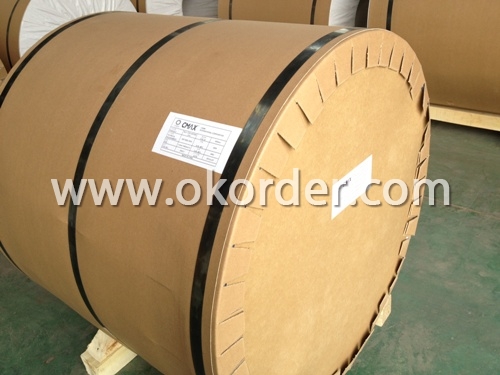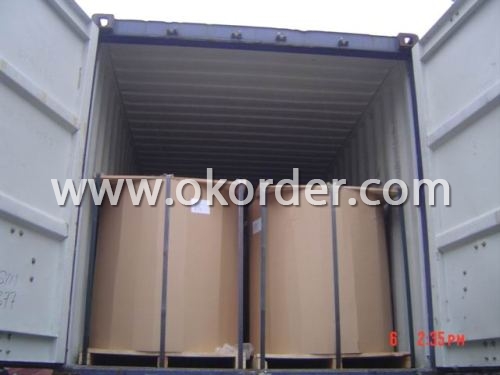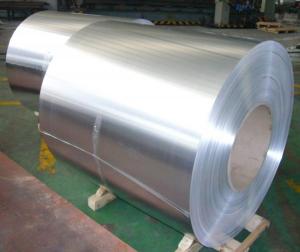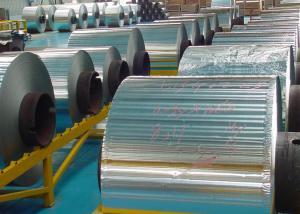6061 Aluminium Coils
- Loading Port:
- China Main Port
- Payment Terms:
- TT or L/C
- Min Order Qty:
- 3 Tons m.t.
- Supply Capability:
- 10000 Tons Per Month m.t./month
OKorder Service Pledge
OKorder Financial Service
You Might Also Like
1. Specifications of 6061 Aluminium Coils
|
Alloy |
AA6061 |
|
Temper: |
T, H112, H12, H14, H16, H18, H22, H24, H26, H32,HO, F |
|
Thickness: |
0.10-500mm |
|
Width: |
10mm- 2200mm |
|
Standard: |
GB/T3880-2006, ASTM, ISO, EU standard |
|
Special Specification is available on customer’s requirement | |

2. Applications of 6061 Aluminium Coils
6061 Aluminium Coils have high / medium strength, good mechanical properties and good corrosion resistance. The alloy can be well anodized, so it is applied to various structural component requiring medium strength, high weldability and corrosion resistance, such as plate, tube, bar and section material used in truck, tower building, vessel, trolley, railway vehicle and furniture.
3. Package & Delivery of 6061 Aluminium Coils
Seaworthy package, water-proof paper wrapped inside, carton wrapped outside in wooden pallets by 20FCL or 40GP.

4. Production Flow of 6061 Aluminium Coils
The main producingprocedure of 6061 Aluminium Coils includes the following steps:
Rolling--Annealing--Slitting--Sawing, Cut-To-Length, Shearing
- Q:Are the aluminum sheets suitable for manufacturing automotive chassis?
- Indeed, automotive chassis manufacturing can make use of aluminum sheets. Aluminum, being a lightweight and durable material, is an excellent option for constructing automotive chassis. Its qualities make it an ideal choice, as it offers various advantages such as enhanced fuel efficiency, improved handling, and increased structural rigidity. Moreover, aluminum possesses the ability to absorb and disperse impact energy effectively, thereby enhancing passenger safety. Additionally, its resistance to corrosion contributes to the longevity of the chassis. Ultimately, employing aluminum sheets in the manufacturing of automotive chassis yields numerous benefits and is a fitting choice for this purpose.
- Q:Are aluminum sheets suitable for boat building?
- Boat building can definitely benefit from the use of aluminum sheets. This material is widely favored for its many advantageous properties. To begin with, aluminum's lightweight quality makes it a breeze to handle and transport during the boat construction process. Not only does this make things easier, but it also contributes to better fuel efficiency and overall boat performance. Moreover, aluminum boasts excellent resistance to corrosion, particularly in saltwater environments. This makes it an ideal choice for boat building, as it ensures the boat remains durable and maintains its structural integrity even when faced with harsh weather conditions. In addition, aluminum sheets offer a remarkable strength-to-weight ratio, providing a solid and dependable structure for the boat. This strength allows the vessel to withstand the various forces it encounters while sailing, guaranteeing a safe and enjoyable experience for all aboard. Furthermore, aluminum is a versatile material that can be easily molded and shaped into a multitude of boat designs. This flexibility allows for customization and the creation of unique boat structures that can meet specific requirements and preferences. Lastly, it's worth noting that aluminum is an environmentally friendly option. It is fully recyclable, which helps reduce the environmental impact of boat building and promotes a more sustainable approach to marine construction. To sum it up, aluminum sheets are unquestionably suitable for boat building due to their lightweight nature, corrosion resistance, strength, versatility, and eco-friendliness.
- Q:What are the different methods of surface patterning aluminum sheets?
- There are several methods available for surface patterning aluminum sheets, each with its own advantages and applications. Some of the commonly used methods include: 1. Mechanical Etching: This method involves the use of abrasive materials, such as sandpaper or wire brushes, to create patterns on the surface of the aluminum sheet. By applying varying pressure and movement, desired patterns can be achieved. Mechanical etching is a cost-effective and versatile method, suitable for creating simple to complex patterns. 2. Chemical Etching: Also known as chemical milling, this method uses chemicals to selectively remove material from the aluminum surface, creating patterns. The aluminum sheet is coated with a resist and then immersed in an etchant solution that dissolves the exposed areas, leaving behind the desired pattern. Chemical etching allows for precise and intricate designs but requires careful control of the etching process. 3. Laser Engraving: This method utilizes a high-power laser beam to remove material from the aluminum surface and create patterns. The laser beam is controlled by computer software, allowing for precise and detailed designs. Laser engraving is suitable for both small and large-scale production and offers high accuracy and repeatability. 4. Embossing: In this method, the aluminum sheet is pressed between two dies that have raised patterns, creating a three-dimensional design on the surface. Embossing can be done through mechanical or hydraulic presses and is commonly used to add texture and aesthetic appeal to aluminum sheets, such as for decorative purposes or branding. 5. Printing: Various printing techniques can be used to apply patterns onto aluminum sheets. These include screen printing, where ink is forced through a mesh screen onto the aluminum surface, and digital printing, which uses inkjet technology for high-resolution patterns. Printing methods allow for a wide range of colors and designs, making them suitable for decorative applications. The choice of surface patterning method depends on factors such as the desired pattern complexity, production volume, cost considerations, and the intended end-use of the aluminum sheets. Each method offers unique advantages and limitations, and manufacturers can select the most appropriate technique based on their specific requirements.
- Q:Can aluminum sheets be used for food display cases?
- Yes, aluminum sheets can be used for food display cases. Aluminum is a popular choice for food display cases due to its exceptional strength, durability, and resistance to corrosion. Additionally, aluminum is lightweight, making it easier to handle and transport the display cases. Its clean, sleek appearance also enhances the presentation of the food items, making it an ideal material for showcasing various food products. Moreover, aluminum is non-toxic and does not react with food, ensuring the safety and hygiene of the displayed items. Overall, aluminum sheets are a suitable and practical choice for constructing food display cases.
- Q:Are aluminum sheets suitable for aircraft manufacturing?
- Yes, aluminum sheets are widely used in aircraft manufacturing due to their lightweight, high strength-to-weight ratio, excellent corrosion resistance, and good formability.
- Q:What are the applications of aluminum sheets?
- Aluminum sheets have a wide range of applications due to their unique properties and versatility. Some common applications of aluminum sheets include: 1. Construction: Aluminum sheets are used in the construction industry for various purposes such as roofing, siding, gutters, and facades. They offer excellent durability, corrosion resistance, and the ability to withstand extreme weather conditions. 2. Transportation: Aluminum sheets are extensively used in the transportation industry, particularly in the manufacturing of automobiles, airplanes, trains, and ships. Their lightweight nature helps reduce fuel consumption and enhance vehicle performance while maintaining strength and durability. 3. Packaging: Aluminum sheets are widely used for packaging purposes, especially in the food and beverage industry. They are used for making cans, foils, and containers due to their ability to protect the contents from light, moisture, air, and bacteria. 4. Electronics: Aluminum sheets are used in the production of electronic devices, such as laptops, smartphones, and tablets. They are often used for heat dissipation due to their excellent thermal conductivity properties, ensuring the longevity and performance of electronic components. 5. Industrial applications: Aluminum sheets find applications in various industrial sectors, including aerospace, marine, chemical, and energy. They are used for manufacturing heat exchangers, tanks, pipes, and other equipment, thanks to their corrosion resistance and high strength-to-weight ratio. 6. Decorative purposes: Aluminum sheets are also utilized for decorative purposes in architecture and interior design. They can be easily shaped, colored, and textured to create attractive facades, wall panels, ceilings, and furniture. 7. Reflective surfaces: Aluminum sheets are commonly used for their reflective properties. They are used in mirrors, solar panels, light fixtures, and reflective signage to enhance brightness and improve energy efficiency. In summary, aluminum sheets are widely used in multiple industries due to their exceptional properties. Their lightweight, durability, corrosion resistance, and thermal conductivity make them a preferred choice for construction, transportation, packaging, electronics, industrial applications, decoration, and reflective surfaces.
- Q:Are the aluminum sheets suitable for welding?
- Aluminum sheets can indeed be welded. Welding aluminum is a popular choice because of its lightweight nature, high strength-to-weight ratio, and resistance to corrosion. Nevertheless, it is crucial to acknowledge that welding aluminum necessitates specific techniques and considerations that differ from those used with other metals. Aluminum possesses a lower melting point and higher thermal conductivity, making it more challenging to weld when compared to steel or other metals. For this reason, specialized welding processes like Tungsten Inert Gas (TIG) welding or Metal Inert Gas (MIG) welding with a spool gun are frequently employed for aluminum welding. Moreover, proper cleaning and preparation of the aluminum surface, along with the utilization of appropriate filler materials, are essential for achieving strong and enduring welds. In conclusion, by utilizing the appropriate equipment, techniques, and expertise, it is possible to successfully weld aluminum sheets and create various structures and components.
- Q:Are 101 aluminum sheets suitable for medical equipment?
- Yes, 101 aluminum sheets are suitable for medical equipment.
- Q:How do aluminum sheets compare to other metals in terms of strength?
- Aluminum sheets are generally not as strong as some other metals such as steel or titanium, but they offer a good balance between strength and weight, making them suitable for a wide range of applications.
- Q:How do aluminum sheets perform in terms of flexural strength?
- Aluminum sheets generally exhibit excellent flexural strength properties. Due to their inherent structural integrity and high strength-to-weight ratio, aluminum sheets are capable of withstanding bending forces without significant deformation or failure. The flexural strength of aluminum sheets can vary depending on the alloy and temper selected, as well as the thickness of the sheet. However, in general, aluminum sheets are known to exhibit good resistance to bending and can withstand applied loads without buckling or breaking. This makes aluminum sheets suitable for various applications that require components to withstand flexural stresses, such as in the construction, automotive, aerospace, and marine industries. Additionally, aluminum sheets can be further enhanced through various fabrication techniques and alloying elements to optimize their flexural strength for specific applications.
1. Manufacturer Overview |
|
|---|---|
| Location | Henan,China |
| Year Established | 2002 |
| Annual Output Value | Above US$200 Million |
| Main Markets | Mid East;Eastern Europe;North America |
| Company Certifications | ISO 9001:2000;ISO 14001:2004;OHSAS 18001 |
2. Manufacturer Certificates |
|
|---|---|
| a) Certification Name | |
| Range | |
| Reference | |
| Validity Period | |
3. Manufacturer Capability |
|
|---|---|
| a)Trade Capacity | |
| Nearest Port | Shanghai |
| Export Percentage | 30%-50% |
| No.of Employees in Trade Department | 21-50 People |
| Language Spoken: | English;Chinese |
| b)Factory Information | |
| Factory Size: | Above 100,000 square meters |
| No. of Production Lines | Above 10 |
| Contract Manufacturing | OEM Service Offered;Design Service Offered |
| Product Price Range | Average |
Send your message to us
6061 Aluminium Coils
- Loading Port:
- China Main Port
- Payment Terms:
- TT or L/C
- Min Order Qty:
- 3 Tons m.t.
- Supply Capability:
- 10000 Tons Per Month m.t./month
OKorder Service Pledge
OKorder Financial Service
Similar products
New products
Hot products
Related keywords






























